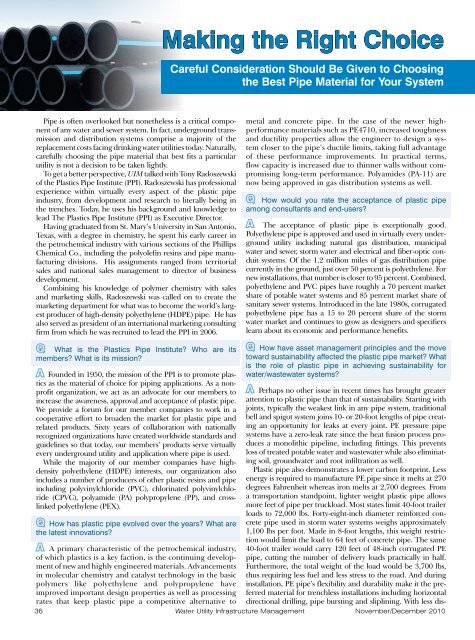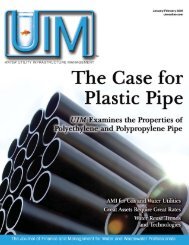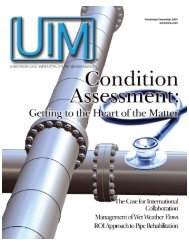Making the Right ChoiceCareful Consideration Should Be Given to Choosingthe Best Pipe Material for Your SystemPipe is often overlooked but nonetheless is a critical componentof any water and sewer system. In fact, underground transmissionand distribution systems comprise a majority of thereplacement costs facing drinking water utilities today. Naturally,carefully choosing the pipe material that best fits a particularutility is not a decision to be taken lightly.To get a better perspective, UIM talked with Tony Radoszewskiof the Plastics Pipe Institute (PPI). Radoszewski has professionalexperience within virtually every aspect of the plastic pipeindustry, from development and research to literally being inthe trenches. Today, he uses his background and knowledge tolead The Plastics Pipe Institute (PPI) as Executive Director.Having graduated from St. Mary’s University in San Antonio,Texas, with a degree in chemistry, he spent his early career inthe petrochemical industry with various sections of the PhillipsChemical Co., including the polyolefin resins and pipe manufacturingdivisions. His assignments ranged from territorialsales and national sales management to director of businessdevelopment.Combining his knowledge of polymer chemistry with salesand marketing skills, Radoszewski was called on to create themarketing department for what was to become the world’s largestproducer of high-density polyethylene (HDPE) pipe. He hasalso served as president of an international marketing consultingfirm from which he was recruited to lead the PPI in 2006.metal and concrete pipe. In the case of the newer highperformancematerials such as PE4710, increased toughnessand ductility properties allow the engineer to design a systemcloser to the pipe’s ductile limits, taking full advantageof these performance improvements. In practical terms,flow capacity is increased due to thinner walls without compromisinglong-term performance. Polyamides (PA-11) arenow being approved in gas distribution systems as well.How would you rate the acceptance of plastic pipeamong consultants and end-users?The acceptance of plastic pipe is exceptionally good.Polyethylene pipe is approved and used in virtually every undergroundutility including natural gas distribution, municipalwater and sewer, storm water and electrical and fiber-optic conduitsystems. Of the 1.2 million miles of gas distribution pipecurrently in the ground, just over 50 percent is polyethylene. Fornew installations, that number is closer to 95 percent. Combined,polyethylene and PVC pipes have roughly a 70 percent marketshare of potable water systems and 85 percent market share ofsanitary sewer systems. Introduced in the late 1980s, corrugatedpolyethylene pipe has a 15 to 20 percent share of the stormwater market and continues to grow as designers and specifierslearn about its economic and performance benefits.What is the Plastics Pipe Institute? Who are itsmembers? What is its mission?Founded in 1950, the mission of the PPI is to promote plasticsas the material of choice for piping applications. As a nonprofitorganization, we act as an advocate for our members toincrease the awareness, approval and acceptance of plastic pipe.We provide a forum for our member companies to work in acooperative effort to broaden the market for plastic pipe andrelated products. Sixty years of collaboration with nationallyrecognized organizations have created worldwide standards andguidelines so that today, our members’ products serve virtuallyevery underground utility and application where pipe is used.While the majority of our member companies have highdensitypolyethylene (HDPE) interests, our organization alsoincludes a number of producers of other plastic resins and pipeincluding polyvinylchloride (PVC), chlorinated polyvinylchloride(CPVC), polyamide (PA) polypropylene (PP), and crosslinkedpolyethylene (PEX).How has plastic pipe evolved over the years? What arethe latest innovations?A primary characteristic of the petrochemical industry,of which plastics is a key faction, is the continuing developmentof new and highly engineered materials. Advancementsin molecular chemistry and catalyst technology in the basicpolymers like polyethylene and polypropylene haveimproved important design properties as well as processingrates that keep plastic pipe a competitive alternative toHow have asset management principles and the movetoward sustainability affected the plastic pipe market? Whatis the role of plastic pipe in achieving sustainability forwater/wastewater systems?Perhaps no other issue in recent times has brought greaterattention to plastic pipe than that of sustainability. Starting withjoints, typically the weakest link in any pipe system, traditionalbell and spigot system joins 10- or 20-foot lengths of pipe creatingan opportunity for leaks at every joint. PE pressure pipesystems have a zero-leak rate since the heat fusion process producesa monolithic pipeline, including fittings. This preventsloss of treated potable water and wastewater while also eliminatingsoil, groundwater and root infiltration as well.Plastic pipe also demonstrates a lower carbon footprint. Lessenergy is required to manufacture PE pipe since it melts at 270degrees Fahrenheit whereas iron melts at 2,700 degrees. Froma transportation standpoint, lighter weight plastic pipe allowsmore feet of pipe per truckload. Most states limit 40-foot trailerloads to 72,000 lbs. Forty-eight-inch diameter reinforced concretepipe used in storm water systems weighs approximately1,100 lbs per foot. Made in 8-foot lengths, this weight restrictionwould limit the load to 64 feet of concrete pipe. The same40-foot trailer would carry 120 feet of 48-inch corrugated PEpipe, cutting the number of delivery loads practically in half.Furthermore, the total weight of the load would be 3,700 lbs,thus requiring less fuel and less stress to the road. And duringinstallation, PE pipe’s flexibility and durability make it the preferredmaterial for trenchless installations including horizontaldirectional drilling, pipe bursting and sliplining. With less dis-36 <strong>Water</strong> <strong>Utility</strong> <strong>Infrastructure</strong> <strong>Management</strong>November/December 2010
uption to streets, pedestrians and traffic installation costs tendto be less expensive and at a lower energy price as well.The long-term service life of plastic pipe systems alsoenhances its sustainability. Since polyethylene pipe does notrust, it s resistant to tuberculation in water pipes. Thesetubercles are small mounds of ferric compounds that form onthe inside of steel or iron pipes. As these tubercles grow, theyroughen the inside of the iron pipe, increasing its resistanceto water flow and decreasing pipe capacity and its projectedservice life. Storm water systems are also subjected to harshchemicals and aggressive flow conditions. Polyethylene isunaffected by roadway salts, brackish water and other roadwaypollutants. It also demonstrates better resistance to abrasionthan concrete or metal, making it not only an acceptablechoice for storm water systems but also a preferred materialfor use in aggressive drainage applications.PE pressure pipe and storm sewer pipe have calculatedservice lives of well over 100 years and at the end of its servicelife, PE pipe can be recycled or used as a fuel source forwaste to energy systems.What is the most common misconception about plasticpipe? How do you seek to educate end-users about them?Because of plastic pipe’s light weight and flexibility thereis a belief it is not strong enough to handle the application.This is contradictory to fact when one considers the marketof share plastic pipe. Those designers and specifiers whohave already used plastic pipe have recognized its significantfeatures and benefits. For others, we continue to presentrelative data and case studies, either in person, at tradeshows or through media outlets to create a better awarenessof plastic pipe and how it has been used successfully in theUnited States and around the globe.What decision-making criteria should an end-userconsider when making a purchasing decision regardingpipe materials?In all candor, the first criterion is to have an open mind whenconsidering pipe materials. Familiarity brings contentment butnot necessarily the best product for the job. Advances in materials,especially plastics, are quite dynamic and provide solutionsto recurrent and vexing problems. The second criterion is anhonest and in-depth assessment of performance life. Thisrequires a full understanding (or projection) of the lifetime operatingrequirements and conditions of the pipe system along withawareness of other environmental or extraneous conditions. Forexample, what are the required hydraulic demands for the systemand will the system still meet those requirements throughoutits lifetime? What effect will corrosion, tuberculation androot infiltration have? What is the potential for leaks or soil/groundwater infiltration? How does the water chemistry or effluentaffect long-term performance? What are the soil conditionsand is the area prone to ground shift or earthquakes? The thirdcriterion is cost. Like performance life, there are many variablesthat need to be evaluated. Short-term considerations includecost of the pipe and fittings and the cost of installation.Depending on the type of pipe used, there are different optionsavailable, including open-cut and trenchless, that must be evaluated.Are there other installation requirements needed such asthrust blocks for water systems or fusion equipment to join thepipe? Long-term costs relate mostly to maintenance. If the pipeis prone to chemical attack, brittleness or infiltration, what arethe associated costs for repair and cleaning of the lines? TheNovember/December 2010fourth and last criterion must be consideration of the followingquestion: “Without compromising performance of the pipe system,which has the best impact on the environment?” Today’sowners and specifiers have a keener interest in the environmentthan ever before and designers need to be sensitive to this issue.Plastic pipe is often the best solution.How is the current economy affecting the pipe market?What are the short- and long-term prospects?Housing starts plays a key role in the demand for pipe.As an early economic indicator, our industry started seeingthe effects of the slowdown in 2006. Site development forutility installations including water, sewer, storm and gas wasdramatically hit in 2007 and of course 2008 when the wheelsfell off of the entire economy. Fortunately we serve manyother industries including oil and gas gathering and geothermalsystems that have been exceptionally strong overthe last few years. Like many other industries, we have seena rebound in 2010 and are cautiously optimistic that theongoing economic recovery will continue to increase demandfor pipe. Longer term we see the replacement market forwater, sewer and storm water systems as a significant growthopportunity. Trenchless installation, specifically pipe bursting,will be significant in the demand for PE pipe.What effect, if any, has the American Recovery andReinvestment Act (ARRA) had on the pipe market? Whatabout the water/wastewater market in general?Unfortunately from our standpoint, ARRA has a negligibleeffect for plastic pipe. It seems underground infrastructure hastaken a back seat to the more visible road work and other aboveground construction projects. Our research indicates that asignificant amount of this money has yet to be spent but we arestill not counting on any significant impact. We see moreopportunity in Clean <strong>Water</strong> State Revolving Funds andDrinking <strong>Water</strong> State Revolving Funds (SRFs). These SRFshave proven to be some of the most successful federal programsfor providing financial assistance combined with stateand local control of spending priorities. Administered throughEPA, these federally supported programs provided approximately$6 billion for wastewater and $1.4 billion for drinkingwater in fiscal year 2010. In light of the projected $540 billiongap estimated by the EPA, this is a mere drop in the bucket forwhat is truly needed. If Congress would increase the amount ofthese low interest, flexible loans we would see a tremendousincrease in demand for plastic pipe.Plastic pipe, particularly HDPE, is commonly used intrenchless installations. What trends have you seen regardingthe use of trenchless? What impact do these trendshave on the pipe market?As the awareness and acceptance of trenchless installationincreases, so does the confidence in this technique and the useof PE pipe. Starting with smaller diameter pipe (4-inch andunder) we are now seeing larger diameter pipe systems employingthis installation process. Gas utilities have been using trenchlessfor quite some time and many of the gas utility contractorsare now bidding more and more for municipal water projects.We are also seeing some assimilation between gas and waterutilities, which further brings trenchless awareness to the watermarket. As this trend continues, we anticipate increasing demandfor trenchless and for PE pipe.<strong>Water</strong> <strong>Utility</strong> <strong>Infrastructure</strong> <strong>Management</strong> 37








